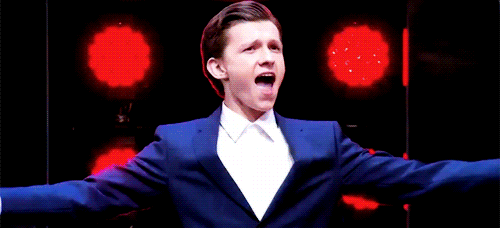“After the blazing success of
Birdman, Michael Keaton returns to don the wings and become the
feathery super character once
more, with this sequel...”
“Wait, what is this?”
“What? It’s the review for
Birdman 2.”
“There’s... no such movie. What’re
you smoking?”
“But Michael Keaton plays this
winged bird-like character, in New York City? So I thought, naturally...
Birdman, you know...”
“It’s Vulture, goddammit!! And it’s
the villain in SPIDERMAN: HOMECOMING, a SUPERHERO film in the MARVEL CINEMATIC
UNIVERSE!! Get your head out of your bugle! Sheesh!”
“... My bad.”
So Kevin Feige presents us with
the 16th installment under the MCU with a completely new film on a superhero we’ve...
seen before. 2 of them, as a matter of fact.
So... what’s new and improved
over the predecessors?
EVERYTHING! <almost>
Like we all know, Peter Parker is
a high school student who was bitten by the radioactive spider and became extra
sticky and whatnot, and eventually dons the red and blue to prevent crime in
New York City. But being a high school student in the 2010s, especially in the
super-advanced Marvel Cinematic Universe, the character and his world needed
some upgrades. Technical, and cultural. Being a millennial high school student,
Peter Parker has finally been tailormade as one.

The film starts with the video
chronicle created by Peter Parker (Tom Holland) while fighting
#TeamCap in Civil
War, self-bragging about his adventures after being temporarily being recruited
by Tony Stark, up until the point where Tony drops him home in Queens with a
high-tech spidey suit with the veiled promise that he ‘might’ be called upon to
be an Avenger. The rest of the story covers his journey as a high-school
student who must try and fit his alter ego somewhere between his ordinarily complex
life.
Being one of the most successful superhero
names of all time, and the company mascot for Marvel, AND being a original
member of the Avengers, it was about time that Marvel inducted the character into
their current Avenger universe. Where Spiderman: Homecoming rises above its
predecessors, is realising and poking fun at some of the most obvious questions
that have been asked by the prudent fans since a long time, such as –
·
How effective a superhero would he be in the
suburbs, where there is an obvious lack of tall buildings to swing from?
·
How effective a superhero would you be on a
boat, WHERE there is an obvious lack of any structures whatsoever to swing from?
·
How the heck is he able to avoid all sorts of
nosey questions about being missing without explanation from crucial social
situations?
The most commendable feature of
this movie is that at no single point, does it dwell. Like I said, it starts
off by the video chronicle by Peter, and the rest of it is told in the same way
as a teenager verbally recounting his far-fetched experiences after an exciting
day, and though the same tends to get boring, it works extremely well here
because we’re able to grasp the visuals of that story, with no unnecessary
extra detail, and moving on with rambunctious energy toward the next sequence.
Sometimes this pace is too fast for comfort, but it works mostly.

The narrative and the characters
are like a sitcom at so many places, they could actually rename this movie as “Spidey
and Friends”. Marisa Tomei as May (no more ‘Aunt’, because younger and hotter),
Zendaya as Michelle Jones and Tony Revolori as Flash Thompson provide quick,
random and wacky comic relief reminiscent to the side characters in some television
sitcom.
Fans get introduced to a new side
of Tony, who seems to be nurturing a mentor-protege relationship with Peter,
who he can’t simply drop back into his world upto his own devices, after using
his help in Civil War, and knowing the possibilities and extent of Peter’s
Powers, and the situations the latter could find himself stranded in without
the proper training and guidance of a veteran (
not that Tony himself is a golden example, but anyhow).
Getting to the new Spiderman, Tom
Holland, all praises fall short to express the good time that this guy provided
as the titular character. The young English actor and dancer completely drowns
himself into the character Spiderman, quite literally, performing nearly all
the stunts and action sequences himself, and having fun at his job with
boisterous, energetic and youthful appeal. To be able to steal the show
surrounded by a cast of industry veterans is a feat that requires no
validation.

Speaking about the villain,
Birdman... sorry, ‘Vulture’ who is quite aptly named, considering the fact that
he literally lives off the alien and robotic scraps from the battles involving the
Avengers in New York (Avengers, 2012) and Sokovia (Age of Ultron, 2015) that he
salvages and sells as high-tech black-market weapons (to street thugs?),
Michael Keaton looks good as the same. Though his performance more-than-often
verges on textbook-comic-book-supervillain, he possesses a natural element of
intimidation that works pretty well, particularly in the scenes involving him
and Peter. His characterisation is quite spot-on as it combines the stereotypical
comicbook sense of evil, but lacking the megalomaniacal attitude, and having
the grounded reasonability of Willem Dafoe’s Norman Osborn (Spiderman, 2002).
Additional talent includes
Jennifer Connolly who voices Karen, the Artifical Intelligence in Peter’s suit.
<FUN FACT: Jennifer Connolly
is the wife of Paul Bettany, who voiced J.A.R.V.I.S. and played the Vision>
VERDICT: 3 

 and a half
and a half /5 toots of
the bugle
/5 toots of
the bugle
 |
Keep hangin' in there, Pedro! |
Marvel Studios maintains its impeccably premium track record with Spiderman: Homecoming. With a wee bit room for growth.
P.S. As is usual with any Marvel movies, you don't want to miss the end-credit cookie by Captain America! At. Any. Cost.
 and a ½
and a ½  / 5 toots of
the bugle
/ 5 toots of
the bugle














